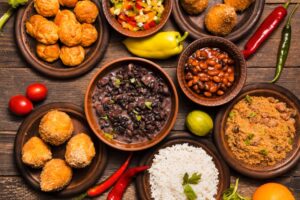
Embarking on a gastronomic journey, we delve into the world of unusual cooking techniques practiced across different cultures. Beyond the familiar methods, these culinary traditions offer a unique blend of creativity, cultural richness, and a dash of culinary ingenuity. Join us as we explore the lesser-known ways people around the world transform ingredients into delicious masterpieces.
- Chinese Tea Smoking: Infusing Flavor with FragranceIn Chinese cuisine, tea smoking involves using tea leaves as a flavorful element in the cooking process. Meats, seafood, or even vegetables are exposed to fragrant tea smoke, creating dishes that not only taste exceptional but also carry a distinctive aroma.
- Peruvian Ceviche: Citrus-Cured DelicacyPeruvian ceviche stands out for its unconventional method of “cooking” fish. Raw fish is marinated in a vibrant mixture of lime or lemon juice, effectively “cooking” the fish without heat. The result is a zesty and refreshing dish with a unique texture and flavor.
- Pit Cooking in New Zealand: Harnessing Earth’s HeatMaori cuisine in New Zealand often involves the traditional method of Hangi, where food is cooked in an underground pit. Heated stones, coupled with the earth’s natural heat, create a slow-cooking method that imparts a distinct flavor to the ingredients.
- Japanese Fermentation: Umami UnleashedBeyond sushi and sashimi, Japanese cuisine boasts various fermented delicacies. Techniques like nukazuke (pickling in rice bran) and miso fermentation contribute to the rich umami flavors that characterize Japanese dishes, offering a depth of taste that goes beyond ordinary seasonings.
- Moroccan Tagine: Slow-Cooking MagicThe Moroccan tagine is not just a vessel but a unique cooking technique. Slow-cooking in a conical-shaped clay pot allows flavors to meld and intensify, creating tender and aromatic dishes that capture the essence of Moroccan cuisine.
- Indian Dum Pukht: Sealed in FlavorOriginating from the Indian subcontinent, Dum Pukht involves slow-cooking food in a sealed container. The dish simmers in its juices, allowing flavors to intensify. This technique is renowned for creating succulent and aromatic dishes, particularly in traditional Mughlai cuisine.
- Swedish Rökning: Cold Smoking for PreservationIn Sweden, cold smoking is used not only for flavor but also for preservation. Fish, particularly salmon, is cured and exposed to cold smoke, resulting in a distinct taste that has become a staple in Scandinavian cuisine.
- Hawaiian Imu: Earth Oven CookingHawaiian cooking often involves the Imu, an underground oven. The method includes slow-cooking meats, vegetables, or even whole pigs using heated lava rocks, infusing the food with a unique smoky flavor.
- South African Braai: Beyond BarbecuingThe South African braai is more than just a barbecue; it’s a cultural event. Typically involving open flames and slow-cooking, this technique imparts a distinct smokiness to meats, creating a communal atmosphere centered around the art of grilling.
- Mexican Mole: Complex Sauce MasteryMole, a rich and flavorful sauce in Mexican cuisine, involves a complex process of toasting and grinding numerous ingredients, including spices, chili peppers, and even chocolate. The result is a symphony of flavors that enhances various dishes, from meats to enchiladas.
- Indonesian Rendang: Slow Cooking MagicHailing from Indonesia, Rendang is a slow-cooked dish where meat is simmered in coconut milk and a rich blend of spices until it absorbs the flavors. The extended cooking time creates a tender and intensely flavored dish.
- Korean Kimchi Fermentation: Tangy PreservationKimchi, a staple in Korean cuisine, is not just a side dish but a result of meticulous fermentation. Vegetables, most commonly cabbage, undergo a transformative fermentation process, resulting in a tangy and probiotic-rich condiment.
- Italian Pasta Water Magic: Starchy ElixirsIn Italian cuisine, particularly with pasta dishes, the water used to boil pasta is often reserved and incorporated into the sauce. The starchy water helps bind the sauce, creating a creamy texture and enhancing the overall flavor profile.
- Argentinian Parrilla: Open-Flame MasteryThe Argentinian Parrilla involves grilling meat over an open flame, creating a deliciously smoky and charred exterior. This technique highlights the simplicity of cooking with fire, allowing the natural flavors of the meat to shine.
- Turkish Coffee Ground Syrup: Sweet ElixirsTurkish cuisine brings forth a unique way of creating syrup for desserts. Coffee grounds are boiled multiple times to extract flavors, resulting in a concentrated syrup used to sweeten various dishes and desserts.
- Thai Sticky Rice Steaming: Bamboo Basket TechniqueIn Thailand, sticky rice is often steamed using bamboo baskets. This method imparts a distinct aroma to the rice, creating a chewy and flavorful staple that complements various Thai dishes.
- Sicilian Couscous: Hand-Rolling TraditionSicilian couscous differs from its Middle Eastern counterpart. In Sicily, couscous is often hand-rolled and then steamed, creating a unique texture and a delightful accompaniment to various Mediterranean dishes.
- Swiss Raclette: Melting Cheese ArtistryThe Swiss tradition of Raclette involves melting a wheel of cheese and scraping the gooey goodness onto boiled potatoes and other accompaniments. This communal dining experience showcases the art of cheese melting and blending flavors.
Conclusion
Exploring the world’s unusual cooking techniques unveils a tapestry of flavors, methods, and cultural richness. From the earthy aromas of pit cooking to the delicate art of Japanese fermentation, these culinary adventures open a window to the diverse ways people transform ingredients into culinary delights. So, embark on a journey with your taste buds, and discover the extraordinary in the world of global gastronomy.
